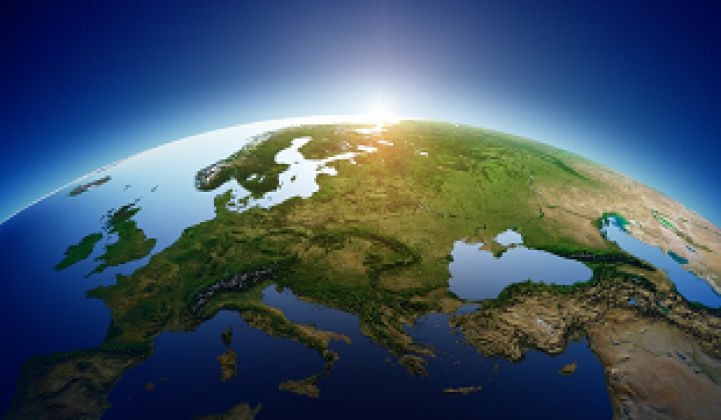In an effort to make the European Union’s economy and energy system more competitive, secure and sustainable, the 28-nation bloc is moving full steam ahead on an aggressive set of climate and energy goals.
EU leaders agreed last week to the binding greenhouse gas reduction target of at least 40 percent by 2030 compared to 1990 levels -- the most ambitious proposal in the world. The policy framework also sets an indicative target to achieve 27 percent in energy savings and a binding target to source at least 27 percent of EU energy consumption from renewable sources over the same period. Currently, the share of renewables EU-wide stands at about 14 percent.
The renewable energy and efficiency goals will not only help to reduce emissions, but are also considered vital for Europe’s energy security. Reducing Europe’s dependency on imported fossil fuels from unstable and unreliable suppliers has become a high priority in light of the ongoing crisis in Ukraine and turmoil in the Middle East.
As part of that effort, the EU plans to speed up the development of an internal energy market. The agreement reached last week includes a 15 percent increase in energy infrastructure and interconnections by 2030.
Still, the targets were hard-fought. “It was not easy, not at all, but we managed to reach a fair decision,” said Herman Van Rompuy, president of the EU Council, the bloc’s highest decision-making body.
Critics have argued that the EU’s sluggish economy won’t be able to handle the actions needed to achieve a 40 percent emissions cut. Retail energy prices have risen consistently since the EU’s 2020 framework was enacted in 2007. The monetary pressure on energy-intensive EU industries is rising to the point where some have threatened to relocate.
Countries also clashed over how to structure the 27 percent renewable energy target. Poland, which relies heavily on coal, and the United Kingdom, which is increasingly exploring the use of nuclear energy and shale gas, reportedly pushed back against the ambitious goal. Germany, meanwhile, is seeking to establish a competitive advantage in renewable energy technology. EU leaders sought to overcome this divergence by setting the target at the bloc level as opposed creating individual member-state mandates.
FIGURE: Renewable Energy 14 Percent of European Energy Mix

Source: European Environment Agency
Environmentalists have criticized this approach, claiming that an EU-level renewable goal means nations have no national accountability. Furthermore, the “indicative” efficiency goal is not enforceable at any level. Lower emissions targets were also offered for eight countries, including Poland, that rely heavily on fossil fuels.
Frauke Thies, policy director for the European Photovoltaic Industry Association, said that the renewable energy target signals that investments in PV will continue, but that it is too low to unlock the full potential of solar. The responsibility now rests with the new European Commission to build on this minimum target with a meaningful legislative framework and fair market conditions for renewables.
“The renewables target is a very small step to support the enormous potential that solar and other renewables represent,” she said in a statement. “It is still an important signal of political resolve to overcome the existing market barriers and the adverse national political contexts where some member states have implemented retroactive measures for renewables.”
The goals come in the lead-up to negotiations in Paris next December on a new international climate agreement that would take effect in 2020. A report released today by the European Commission in partnership with the European Environment Agency shows that the bloc is already well on its way to meeting its existing climate goals.
According to the latest estimates, EU greenhouse gas emissions fell by 1.8 percent in 2013 compared to 2012, which puts total EU emissions around 19 percent below levels in 1990. This puts the EU on track to achieve and even surpass its target for a 20 percent reduction in greenhouse gas emissions by 2020.
Europe’s 2020 goals also include a 20 percent improvement in the EU’s energy efficiency and raising the share of EU energy consumption produced from renewable resources to 20 percent.
The progress report also found that new revenues for member states from auctioning allowances in the EU Emission Trading System amounted to €3.6 billion in 2013. Of this amount, around €3 billion is slated for climate- and energy-related purposes.
"Delivering on 2020 climate goals shows that Europe is ready to step up its act. And better still, it shows that the EU is delivering substantial cuts,” said EU Climate Action Commissioner Connie Hedegaard. “The policies work.”



